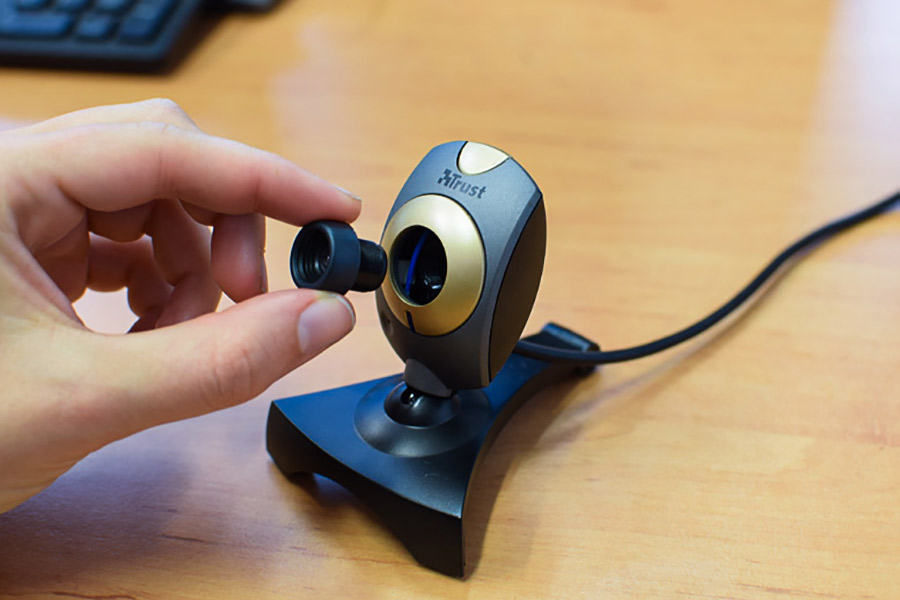
Infrared webcam hack – using infrared light to observe the world in a new way
What would the world look like if we could see infrared light? With some simple modifications, you can turn a cheap webcam into an infrared camera…

This article was adapted from an ESA video, an ESA Science & Exploration article and an ESA Enabling & Support article.
Join ESA’s interplanetary spacecraft Juice on a voyage to the mysterious gas giant Jupiter to uncover the secrets of its intriguing icy moons.
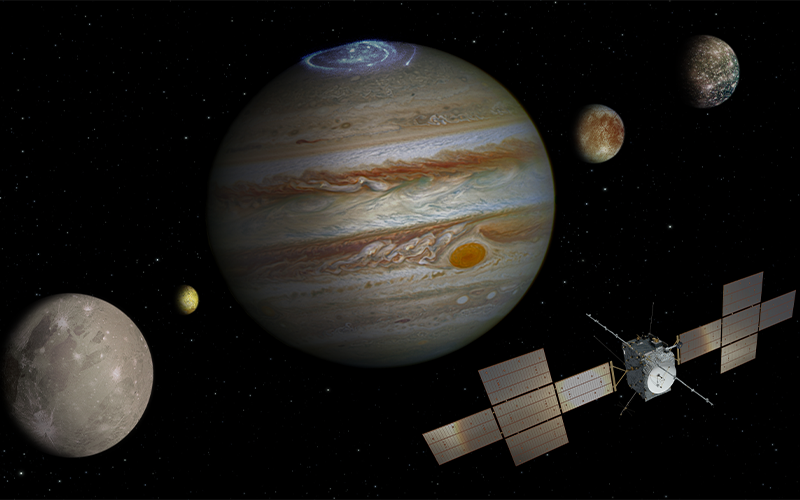
A grand odyssey of exploration has just begun: Humankind’s next bold mission to the outer Solar System, ESA’s Jupiter Icy Moons Explorer (Juice) is poised to explore the giant planet Jupiter and its largest moons.[1,2] These intriguing worlds have piqued our curiosity ever since Galileo first raised his telescope to the planet and discovered its four largest moons: Io, Europa, Ganymede, and Callisto. Juice will be the first spacecraft ever to orbit a moon other than our own.
Early space probes visiting the Jovian system have raised more questions than answers. For example, three of the largest moons are thought to harbour underground oceans based on the NASA Galileo mission findings in early 2000, from which magnetometer data indicated the signature of liquid water inside the moons, but we’re not sure what form it might take or whether some of these moons could support life. Thanks to Juice, many of those answers are now within reach. ESA launched the spacecraft in April 2023 on an eight-year journey to the distant planet.
The spacecraft will face many dangers along the way: radiation, extreme temperatures, and the vast gravitational pull of Jupiter, all while operating hundreds of millions of kilometres from Earth.
To uncover the hidden secrets of these mysterious worlds, Juice is equipped with the most powerful remote sensing and geophysical instruments and the biggest complement of equipment ever flown to the outer Solar System. It includes ten dedicated scientific instruments, a radiation monitor (RADEM), and a planetary radio interferometer & Doppler experiment (PRIDE), which uses radio telescopes on Earth to provide high-precision information on the position and velocity of the spacecraft. These are all powered by 85 m2 of solar wings.
After an eight-year journey to Jupiter, Juice will make detailed observations of the gas giant and its three large ocean-bearing moons: Ganymede, Callisto, and Europa. This ambitious mission will characterize these moons and discover more about these compelling destinations as potential habitats for past or present life. Juice will monitor Jupiter’s complex magnetic, radiation, and plasma environment and its interplay with the moons in depth, studying the Jupiter system as an archetype for gas-giant systems across the Universe.
It’s not possible to stop at a moon, explore, and then go to another one, so most of the observation will be done during flybys. The first part of the mission (2.5–3 years) is a series of orbits around Jupiter, and every second orbit or so Juice will fly past Europa, Callisto, or Ganymede. Finally, Juice will change its course to orbit Ganymede, making it the first spacecraft to ever orbit a moon in the outer Solar System.
Juice’s primary scientific target will be Ganymede, the largest moon in the Solar System – larger even than Mercury.
If we were to dig beneath Ganymede’s 150-km-thick crust of mostly ice, we would likely find an ocean 100 km deep, where primitive life could in theory potentially exist. Juice is going to delve deep into this ocean, but it has no need for a huge drill. Scientists and engineers have worked tirelessly to design special remote sensing instruments to explore the moon while flying past and orbiting around it.
Juice will explore various key topics: Ganymede’s puzzling magnetic field (it is the only moon in the Solar System to generate its own), its hidden ocean, its complex core, its ice content and shell, its interactions with its local environment and that of Jupiter, its past and present activity, and whether or not the moon could be – or ever has been – a habitable environment. Juice’s investigations of the moon will begin in earnest in late 2034, and it will end its mission by colliding with Ganymede’s surface in 2035.
Juice will complete two flybys of Europa in July 2032, with a closest approach of 400 km. During these close encounters, Juice will explore the geology, surface, subsurface, activity, and environment of the moon, which appears to have a young, geologically active, colourful, and distinctively marked surface.
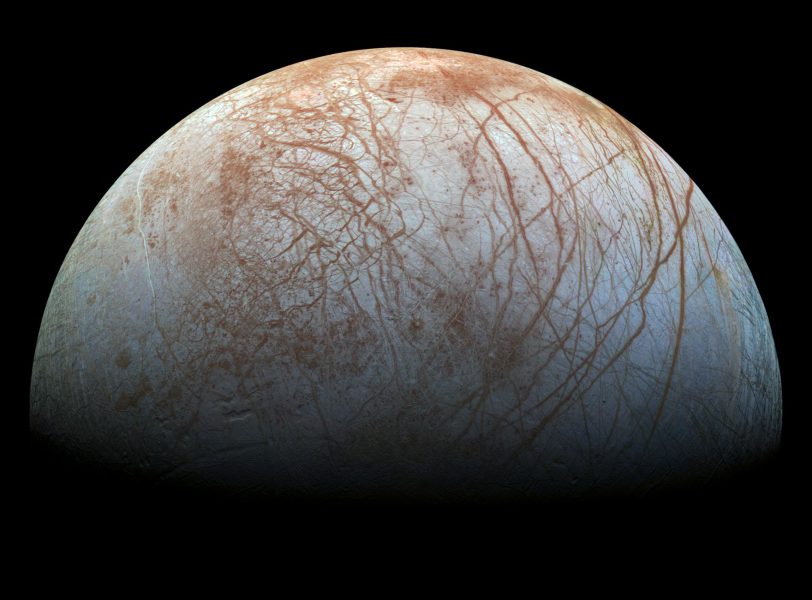
The mission will characterize the composition and chemistry of Europa’s surface, hunting for substances that are essential to support life (‘biosignatures’) and determining the source of the moon’s surface composition. Europa may vent water vapour to space via ‘plumes’ and geysers; Juice will search for pockets of water in the moon’s shallow subsurface using unprecedented ice-penetrating radar, and reveal locations where the transfer of material between subsurface, surface, and space may be especially intense.
Juice will complete its first flyby of Callisto in June 2032; the spacecraft will complete a total of 21 flybys of this moon from 2032 – 2034 (both to explore the moon and to adjust the energy and orientation of Juice’s orbit), coming as close as 200 km from Callisto at its nearest approach.
Previous observations by NASA’s Galileo mission suggest that Callisto has at least partial internal layers; however, its surface is very old and appears to have been geologically inactive for a billion years or so, so it is unclear if the moon has any ongoing internal dynamics. Despite this, Callisto appears to have a magnetic field that is not generated internally, like that of Ganymede, but is instead produced either by a large liquid reservoir lurking below its icy shell or due to interactions in Callisto’s ionized upper atmosphere.
Callisto is also the least geologically evolved Galilean satellite and, therefore, offers a unique glimpse into the environment around early Jupiter. As it does not seem to have evolved much over time, Callisto may reveal unique information about how it initially formed and about the origin of the wider Jupiter system.
Before starting its scientific mission, Juice will need to complete a series of challenging manoeuvres to get into orbit around Jupiter. Juice launched in April 2023 and it will spend approximately eight years cruising to Jupiter. This long voyage time has less to do with the distance between Earth and Jupiter and more to do with fighting the Sun’s massive gravitational pull as it ventures outwards through the Solar System.[3] Juice is one of the heaviest interplanetary probes ever launched (just over 6000 kg) and would be little more than a giant fuel tank if it had to store all the energy needed to overcome the Sun’s gravity by itself. Instead, it makes use of ‘gravity-assist’ or flyby manoeuvres to gain energy by swinging through the strong gravitational fields of Venus and Earth on the way. This includes the first ever Lunar-Earth flyby scheduled for August 2024.
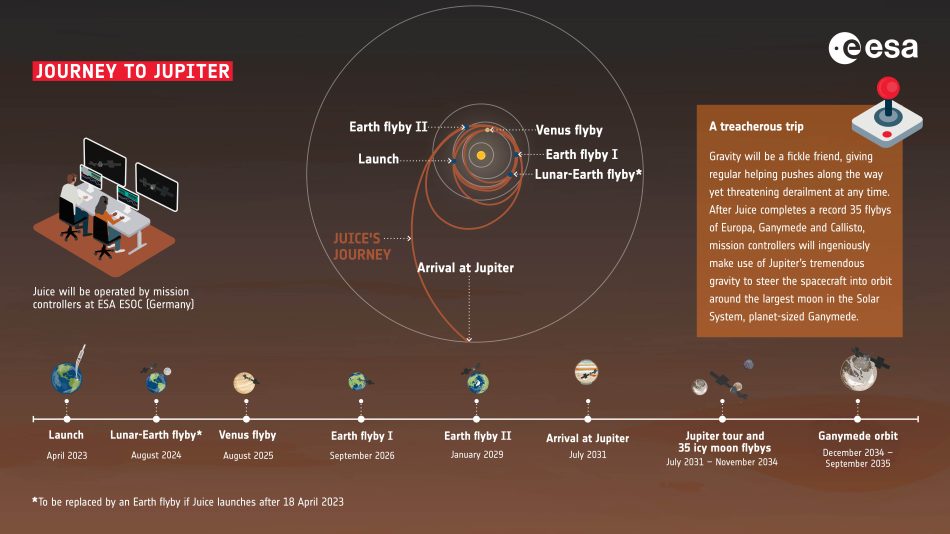
Once it reaches Jupiter, the most challenging part for the control team will start. Getting into orbit around another celestial body is hard. A spacecraft must approach from a precise angle at the perfect speed, then execute a vital, big manoeuvre at just the right moment, in a specific direction, and with the correct magnitude. Approaching too fast or slow, too shallow or steep, or manoeuvring at the wrong time, with the wrong magnitude or direction, and you’re lost in space. Or you’re so far off track that it will take a lot of – perhaps too much – fuel to correct your path. And after that, further complex manoeuvres will be required to set up the mission flybys of Europa, Callisto, and Ganymede.
Then, finally, Juice will be able to begin its mission objective. By investigating Ganymede, Europa and Callisto as a trio, Juice will paint a comparative picture of the environments of each and shed light on their properties and potential habitability. Stay tuned for the mission’s exciting milestones and discoveries!
[1] ESA video on Juice’s odyssey of exploration: https://www.youtube.com/watch?v=Eq8ZOQ9h3D8
[2] ESA article about the moons of Jupiter: https://www.esa.int/Science_Exploration/Space_Science/Juice/The_moons_of_Jupiter_What_will_Juice_discover
[3] ESA article about the travelling time of Juice: https://www.esa.int/Enabling_Support/Operations/Juice_why_s_it_taking_sooo_long
This is not just used as a comprehension exercise. It can be used to promote discussions on challenges and risks of space exploration. If the moons have the right conditions for supporting life, then how long would it take to ‘terra-form’ these moons and how is it possible for humans to survive travelling long distances?
In addition, learners can make a model solar system (including the moons around Jupiter) with craft foam balls of different diameters, which can be painted and labelled. A model of the probe (Juice) is included with its trajectory.
Colin Oates, Physics teacher, Scotland

What would the world look like if we could see infrared light? With some simple modifications, you can turn a cheap webcam into an infrared camera…
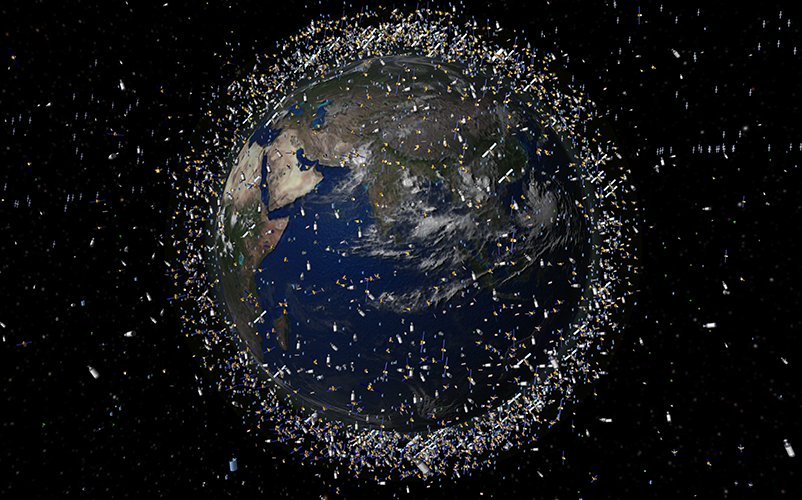
A waste of space: years of human activity in space have left thousands of objects in orbit around the Earth. Learn more about the risks they pose and what we can do about it.
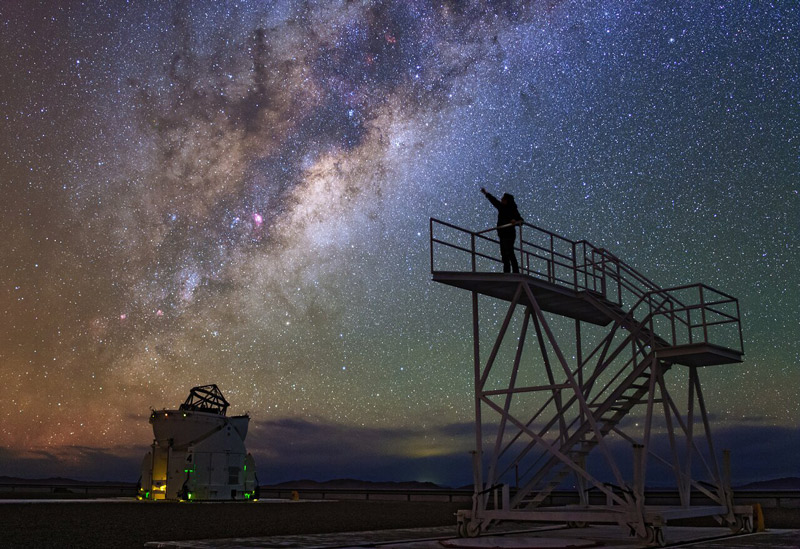
We can’t image our home galaxy from the outside, so how do we study it? Learn how astronomers unveil the dramatic past of the Milky Way and peer into its future.